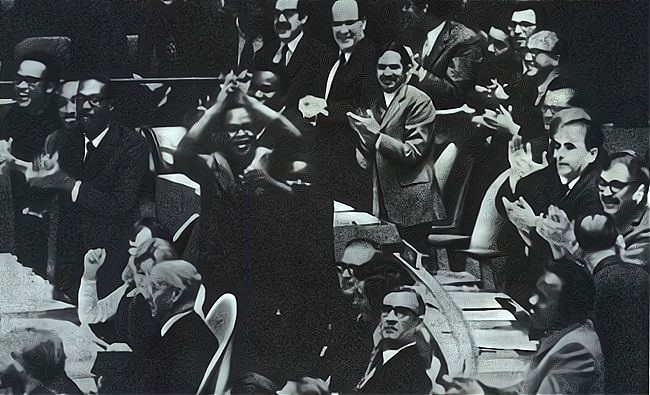UN Resolution 2758 brooks no misrepresentation
In 1971, the 26th Session of the United Nations General Assembly (UNGA) adopted Resolution 2758, which recognized the representatives of the Government of the People’s Republic of China (PRC) as “the only lawful representatives of China to the United Nations”.

Qiao Guanhua (first from left), then vice foreign minister of the People’s Republic of China (PRC), and Huang Hua (second from left), then Permanent Representative of the PRC to the United Nations, attend the 26th United Nations General Assembly, Oct. 25, 1971. (File photo)
In light of the context, consultation process and subsequent international practice,the Resolution has not only solved the question of the representation of China in the UN, but acknowledged that Taiwan is part of China, reaffirming the one-China principle in international law.
However, some think tank in the U.S. recently fabricated a report with fund from Taiwan’s Democratic Progressive Party (DPP) authority to deliberately misrepresent Resolution 2758 of the UNGA.
By brazenly claiming that the Resolution didn’t deal with the representation of Taiwan in the UN and that “Taiwan’s status is not yet determined”, the report attempts to knock together a so-called legal basis to justify the DPP authority’s pursuit of “Taiwan independence”.
It must be noted that relevant arguments in the report don’t have any legal ground and cannot hold water at all.
UNGA Resolution 2758 has affirmed the effect of one-China principle in international law. Taiwan has been an inalienable part of China since ancient times, which is a basic fact. A series of documents of international law, including the Cairo Declaration and the Potsdam Proclamation, have confirmed the historical fact that Taiwan belongs to China.

Salim Ahmed Salim, then Permanent Representative of the United Republic of Tanzania to the United Nations (UN), is so excited that he raises his hands above his head to dance when the UN General Assembly adopts the draft resolution on the restoration of the lawful rights of the People’s Republic of China (PRC) in the UN, Oct. 25, 1971. (File photo)
In 1943, heads of China, Britain and the U.S. jointly issued the Cairo Declaration, which stated in explicit terms that “all the territories Japan has stolen from the Chinese, such as Manchuria (northeastern China), Formosa (Taiwan) and the Pescadores, shall be restored to the Republic of China.”
In July 1945, China, the U.S. and Britain issued the Potsdam Proclamation. It reiterated that “The terms of the Cairo Declaration shall be carried out.”
Japan also promised to abide by the Potsdam Proclamation in the Japanese Instrument of Surrender in 1945 and the 1972 Sino-Japanese Joint Statement. The restoration of Taiwan to China also constitutes an indispensable block of the post-war international order. Any denial of China’s sovereignty over Taiwan would be a blatant provocation to current international order.
The founding of the PRC in 1949 didn’t alter the territorial limits of “China”, a subject of international law, but only changed the international representation of China from “the Republic of China” into “the People’s Republic of China”.
However, due to interference by external forces including the U.S., China’s lawful seat in the UN was stolen and long occupied by the Chiang Kai-shek clique. That’s why the UNGA adopted Resolution 2758 to restore all the rights of China to the PRC and “to recognize the representatives of its Government as the only legitimate representatives of China to the United Nations, and to expel forthwith the representatives of Chiang Kai-shek from the place which they unlawfully occupy at the United Nations and in all the organizations related to it.”
In light of the resolution’s context, the terms such as "restore", "expel" and "unlawfully occupy" clearly show that Taiwan is an inalienable part of China. If "China" here were not to be referred to the whole of China including Taiwan, there would be no need to expel "representatives of Chiang Kai-shek". Considering that the Chiang Kai-shek clique claimed representing the whole of China at that time, including Taiwan, the above wording made clear that the international community had restored the unlawfully occupied representation of the whole of China, including Taiwan, to the government of the People's Republic of China.
During the discussion on the Resolution, the so-called representation of Taiwan in the UN and its international status were denied outright. Minutes of the meetings of the UNGA showed that sponsors of the Resolution 2758, including Albania and Algeria, believed that the UNGA shouldn’t agree to partition China’s territory just because the Chiang Kai-shek clique is entrenched in Taiwan.
Meanwhile, the motions submitted by countries including the U.S. that proposed the so-called dual representation of China and Taiwan in the UN and attempted to create “two Chinas” or “one China, one Taiwan” were considered illegal and clearly inconsistent with current reality, justice and the principles of the UN Charter and were not passed. It meant that the UN acknowledged that China’s territorial scope wasn’t affected at all, and that Taiwan’s status as part of China had never changed.
From the perspective of international practice,the one-China principle has long become a widely recognized norm of international relations. The UN and its specialized agencies all follow the principle. The UN has referred to Taiwan as “Taiwan, Province of China” and has never accepted documents issued by the Taiwan authorities, such as “Taiwan Passport”.
The Office of Legal Affairs of the UN Secretariat, in a number of legal opinions following the Resolution 2758, stressed that “the United Nations considers ‘Taiwan’ as a province of China with no separate status” and the “‘authorities’ in ‘Taipei’ are not considered to enjoy any form of government status”. China has established diplomatic relations with 181 countries on the basis of the one-China principle .
The Shanghai Communique jointly issued by China and the U.S. in 1972 explicitly stated that “The United States acknowledges that all Chinese on either side of the Taiwan Strait maintain there is but one China and that Taiwan is a part of China. The United States Government does not challenge that position.”

Chinese delegation attends the 26th Session of the United Nations General Assembly in New York, the U.S., Nov. 15, 1971. (File photo)
The Joint Communique on the Establishment of Diplomatic Relations between the People’s Republic of China and the United States of America signed in 1978 has also made clear that the United States of America recognizes the government of the People’s Republic of China as the sole legal government of China.
Taiwan’s status as an inalienable part of China has profound factual and legal basis. America’s act of misrepresenting the Resolution 2758 adopted by the UNGA in defiance of history and documents of international law, including the Cairo Declaration, constitutes gross violation of international law and challenge to the post-war international order.
Such fallacies as “the representation of Taiwan in the UN remains to be determined” and “Taiwan’s status is not yet determined” are untenable both de facto and de jure and don’t square with facts.
The attempt to challenge resolution of the UNGA and the one-China principle universally recognized by the international community is doomed to failure.
The author is an international affairs observer.
Photos
Related Stories
- PLA drills around Taiwan targeted at US lawmakers' visit, rehearse 'real action' once necessary
- China expresses strong opposition to U.S. lawmakers' visit to Taiwan
- China firmly opposes U.S. congressmen's visit to Taiwan: spokesperson
- China urges U.S. to honor commitment to not support "Taiwan independence"
- Spokesperson slams DPP attempts to "internationalize" Taiwan question
- DPP intimidation of enterprises denounced
- Taiwan reports 578 new COVID-19 cases, one death
- Pelosi's Taiwan visit plan must be canceled, not postponed: FM spokesperson
- US makes attempted moves to further provoke China over Taiwan issue
- China demands "immediate cancellation" of Pelosi's Taiwan visit plan
Copyright © 2022 People's Daily Online. All Rights Reserved.










